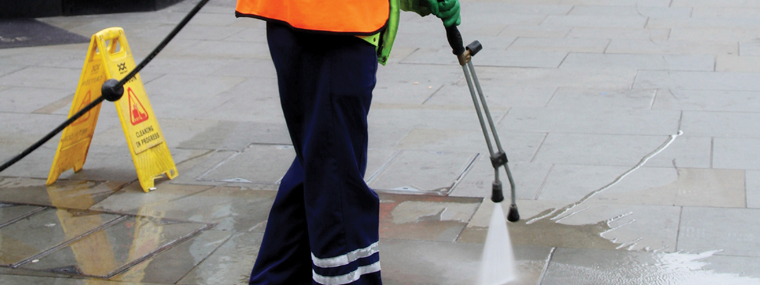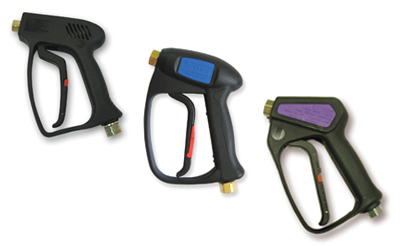
A Pressure Washing Commandment: Know Your Spray Gun
By Diane M. Calabrese / Published June 2016

A contractor may think he knows a spray gun as well as the back of his hand. There’s always something more to recall, however. Always pause now and then to undertake a quick mental refresher on the role, safe use, and proper maintenance of spray guns.
The basics of spray gun maintenance occur at the end of the day when the spray gun is checked for defects and dirt. Repair any obvious defects before using it again. Keep the gun clean. Correspondingly, if a spray gun begins to function erratically or in any way out of the norm, stop using it until the source of the problem can be identified and corrected.
One of the best ways to refresh one’s memory on the do’s and don’ts of a spray gun is to take out the operating manual that came with the gun and/or pressure washer and reread it. It’s easy to forget or, more often, to become inured to what could be subtle warning signs. If something seems to be amiss with a spray gun, assume the worst. Doing so is a matter of safety.
Three industry experts answer some questions on the topic of spray guns: Brian Brunelli, application engineer with Briggs & Stratton Corporation in Milwaukee, WI; Rich Langkamp, manufacturing engineer with Mi-T-M Corporation in Peosta, IA; and Jim Sheperd, general manager with Suttner America Company in Dubuque, IA.
Cleaner Times [CT]: What is the single most important thing a contractor should understand about the role of the spray gun in a pressure washer?
Brunelli: The spray gun and the nozzle are designed to match the output of the pressure washer pump. Changing either to the incorrect size may result in a safety hazard or poor cleaning performance from the pressure washer.
Langkamp: Safety issues with trapping unloaders. Prior to squeezing the gun trigger, make sure you have good footing, with one hand on the gun trigger and the other on the wand to minimize the instantaneous kickback when the gun trigger is pulled.
Sheperd: The contractor needs to understand that the spray gun is the single item that his employees will handle most during the pressure washing process. The selection of the spray gun is critical to the comfort and fatigue of the user; picking the least expensive gun may not be the best long-term solution. The more comfortable the gun is in the hand of the user, the more likely it is that the user will be able to clean longer between rests, thus shortening the time to clean the job. Spray guns are made in different sizes to best fit the user—smaller guns for smaller hands and larger guns for larger hands.
There are different spray guns specifically designed for particular cleaning situations; if the job requires the spray gun to be held open for extended periods of time, there are spray guns that have lower forces to hold the gun open. If the cleaning job is such that the spray gun will be open and closed continuously, then there is a gun designed with low opening forces—all in the attempt to lower hand/arm fatigue.
[Following this Q&A section, there is a section on the topic of an ergonomic standard for spray guns.]
CT: Is there any change in the function of a pressure washer that might signal a problem with a spray gun, as opposed to an obvious problem with the spray gun itself?
Brunelli: Poor cleaning performance may be a sign that the nozzle is either plugged or worn too large. Clean and maintain the nozzle on a regular basis.
Langkamp: A very minute drip will cause the trapped psi to decrease, which will cause the unit to cycle in the bypass mode—the volume of water leaking by the gun seat will determine how often the unit continues to cycle when the gun trigger is off.
Electric units with an auto start/stop feature will cycle off after the unit times out. A leaking gun allows the trapped psi to decrease and eventually restart the pressure washer. If the trapped pressure decreases at a rate that it leaks down to the psi switch’s set pressure before the unit times out, the unit will never shut down and will continue to run in the bypass mode.
It is important for workers going on breaks or leaving for the day to shut the unit’s main power switch off; otherwise the unit will either continue to cycle on/off or continue to run, depending on the severity of the leak.

With hot water units, as the gun, wand, and nozzle start to scale up, reducing the flow of water exiting the nozzle, you may notice the temperature of the water increasing.
CT: Is there a top reason why a spray gun might fail?
Brunelli: If the spray gun should ever leak, stop using it immediately and locate the source of the leak. Usually the cause is a damaged O-ring. Never use your hand to stop any leaks as the high pressure water can cause a serious injury.
Langkamp: Acidic chemicals and excessive temperatures will cause premature failures.
CT: What protocol should a contractor follow in order to identify the optimal spray gun for a particular job?
Brunelli: Spray guns usually come with a variety of tips to perform specific jobs. Always use the widest spray angle first before switching to the narrow angles. Specialty tips and spray gun configurations are available on the market to handle some of the unique situations the contractor may encounter. Always consult the manufacturer of the pressure washer to ensure that a particular specialty spray gun is suitable for that machine.
Langkamp: Ensure the pressure washer gun is rated for the temperature and/or pressure of the unit you are using. I suggest using a true steam gun if the water temperature is above the 250 F range. The nozzle is probably more important when it comes to particular jobs.
Sheperd: There also has been a concentrated effort in the newest spray guns to design them to be as ergonomic as possible, again, reducing fatigue and possible carpal tunnel issues. The spray gun should not be viewed as an afterthought when choosing one; the spray gun plays a critical role in the cleaning process and can have the greatest effect on the user of all of the pressure washer components, so choose wisely.
CT: How should spray guns be maintained? More specifically, is there one thing contractors too often overlook in terms of spray gun maintenance?
Brunelli: The nature of pressure washers is that they are being used in a relatively dirty environment. Spray guns end up on the ground where dirt and sand can fall on the spray gun. If the debris enters any of the sealing areas, such as a connection point with an O-ring, inadvertent damage to the seal may occur. Always check O rings and seals to verify that they are not cracked or damaged. Repairing an O-ring while still at the shop will save some valuable down time in the field.
Langkamp: Run clean water through them; drain the water prior to putting them away. This will also help keep them from freezing in winter months.
Ergonomic Standard?
The topic of creating an ergonomic standard for spray guns brings a great deal of informed debate from all interested parties. The Technical Committee of the Cleaning Equipment Trade Association (CETA) has considered developing an ergonomic spray gun standard.
Requests to the technical committee of CETA from insurance companies seeking an industry-wide, ergonomic spray-gun standard have contributed to the discussion. Developing an ergonomic standard is complicated because human subjects would have to be assessed to evaluate their response to particular designs.
The goal of an ergonomic standard for spray guns is as laudable as it is challenging. Better design could reduce operator fatigue. The reduced fatigue (and reduced repetitive motion) could lead to a reduction in workers’ compensation claims.
An operator expends a great deal of energy in the manual operation of a spray gun. At 2200 psi, it takes an eight-pound force to hold open the trigger gun. It takes a force three times that great to open a trigger gun at 3500 psi. Anything that can be done to reduce operator fatigue will be welcome, to be sure.
Moreover, an operator who does not become fatigued remains alert and capable of doing a better job. That’s one obvious benefit. A less direct but extremely important benefit of a standard will be the protection it affords to manufacturers. If an ergonomic spray gun is used correctly, the operator should not experience repetitive stress or other injury. Or worse…A fatigued operator might hit his own or a coworker’s exposed skin, causing a serious injury. [Note: Injection injuries, even those caused with water alone, should be given immediate medical attention.]
Contractors, manufacturers, and distributors who have thoughts about the development of an ergonomic standard for spray guns can share them with the CETA Technical Committee by contacting members via the general CETA e-mail, info@ceta.org.




